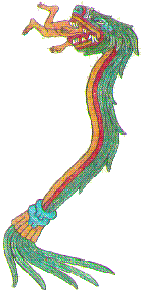Content created: 2001-01-06
File last modified:
Inadequate Nahuatl Lessons
Introduction, About These Lessons
Shortcuts to Lessons:

Introduction
Why Study Nahuatl?
Although there are some speakers of modern Nahuatl in this world, there is not much reason for any normal person would study Classical Nahuatl. Save for a few historians and linguists, and the occasional exceptional ethnographer, most people (including native speakers of modern Nahuatl) can live perfectly adequate lives without it.
On the other hand, Classical Nahuatl arranges ideas in ways that I never encountered before, and leaves me with a satisfying if superficial feeling of deeper understanding of human thought than I had before I took up studying it. Besides, like a mountain waiting to be climbed, Nahuatl is there.
Challenges to the Beginner.
- Nahuatl is built of short elements that are compounded into extremely long ones. One challenge in understanding Nahuatl is to learn to identify the parts.
- There are a few phonological variations that occur at the boundaries that make this task a little trickier than it would otherwise be.
- Word order is relatively flexible, and some of the kinds of pointers other languages use to link parts of sentences together are not immediately evident in Nahuatl. Identifying some of the compounds for what they are made of doesn't always tell you how they relate to other parts of the sentence.
- The vocabulary of Nahuatl is utterly unrelated to languages in Africa and Eurasia, and it proves difficult to remember.
Gifts to the Beginner.
- Nahuatl lacked a widely used indigenous writing system, and became an efficiently written language only after the arrival of the Spanish, so it is represented in Roman letters. (Spelling has always been a bit unstable, but rarely constitutes an actual obstacle to reading a text.)
- Nahuatl does not contain particularly difficult sounds, and the sound contrasts are for the most part easily represented in Roman letters.
- The mutations that occur at element boundaries are quite regular.
- In contrast to European languages, Nahuatl has only a small handful of irregular verbs, and even they are irregular in relatively trivial ways.
Return to top.
About These Lessons
This small group of lessons provides a brief introduction to some of the core features of Classical Nahuatl. You will not learn very much Nahuatl here, but it should give you enough of an introduction to simplify your access to more complete textbooks, or to appreciate what is happening in side-by-side texts where Nahuatl is set in parallel with a translation into a more widely known language.
Technical Stuff: Long Vowels. Classical Nahuatl has a distinction between long and short vowels. In most sources this is either ignored (sometimes with resultant misunderstandings) or is shown by a long mark over the long vowel. Linguists sometimes marked the long vowel by putting a colon after it: a:, e:, i:, o:, u:.
In this set of lessons the long vowels are marked with an umlaut (ä, ë, ï, ö). In some cases, adding a suffix lengthens the previous vowel. To show this I have sometimes placed a colon as the first letter of the suffix: ca+:olli = ca:olli = cäolli.
Technical Stuff: Examples. These lessons teach basic Nahuatl largely by means of examples. They often take the form of fill-in-the-blank quizzes, with some blanks already filled out and with others waiting for you to propose answers.
- If you fill in the wrong answer the depressingly unimaginative Answer Ghost will make it vanish as soon as your mouse leaves the box.
- If you keep trying and your answers keep getting rejected, you can "cry uncle" by clicking your mouse in a nearby "Uncle Box," which will briefly display the correct answer.
- Never use long vowels in the answer boxes. They will be rejected even when they are correct. This saves you figuring out how to enter them from your particular keyboard.
Happy Nahuatling.
Special Thanks
I am indebted to various users of these materials for all sorts of useful suggestions and needed corrections, especially to:
- Local users of the paper version of the lessons:
- Eddie Wright-Rios
- Andrew B. Fisher
- Scott Bohlinger
- Eric Johnson
- Adolfo Muniz
- Katherine Guardado
- On-line users of the electronic version:
- Fabian E. Pena Arellano
- Guillaume Costille
- Steven "Tiger" Lang
Return to top.
